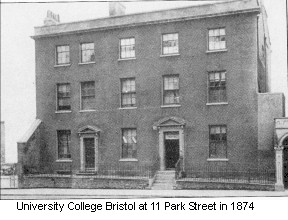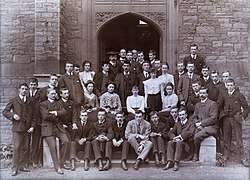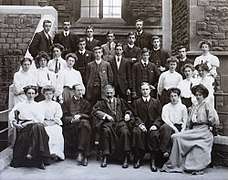Katharine Isabella Williams
Katharine Isabella Williams (c. 1848 - 16 January 1917) was a British woman chemist who became a student, aged 29, at University College Bristol. She was known for her collaboration in the 1880s with Nobel prize winning Scottish chemist, William Ramsay and was also one of the signatories of the 1904 petition for the admission of women to the Chemical Society.[1]
Katharine Isabella Williams | |
|---|---|
| Born | 1848 Llanvapley, Monmouthshire |
| Died | 16 January 1917 Bristol |
| Nationality | British |
| Citizenship | United Kingdom |
| Education | King Edward VI High School for Girls, University College Bristol |
| Known for | Signatory to 1904 petition to join the Chemistry Society |
| Scientific career | |
| Fields | Food analysis |
| Institutions | University College Bristol |
| Academic advisors | William Ramsay |
Life

Katharine Williams was born at Llanvapley in Monmouthshire, daughter of Thomas Williams, later Dean of Llandaff. She was educated at King Edward VI High School for Girls, Birmingham.[1] She resided for much of her life with her elder sister Elizabeth at Llandaff House, 1 Pembroke Vale, in Clifton, Bristol, where she died in 1917.
Research
She worked with William Ramsay on studies of atmospheric gases, before moving on to conduct her own research in food analysis.[2][3] She published for over 14 years, authoring 10 papers,[1] including two published in the Journal of the American Chemical Society (1904 and 1907).[4] In 1909 she was one of the 24 female members of the 7th International Chemical Congress in London,[5] and in 1910, by which time she was in her sixties, she gained a B.Sc. by research from University College Bristol, where she was considered to be one of the few advanced students capable of performing research.[6]
- Chemistry Department at the University of Bristol, in 1898-1899, 1902-1903 and 1907-1908. Katherine Isabelle Williams is likely to be in these pics although there are sadly no markings on the pictures to identify her.
 Chemistry Department staff and students, University College Bristol, 1902-1903
Chemistry Department staff and students, University College Bristol, 1902-1903 Chemistry Department staff and students, University College Bristol, 1898-1899
Chemistry Department staff and students, University College Bristol, 1898-1899 Chemistry Department staff and students, University College Bristol, 1907-1908
Chemistry Department staff and students, University College Bristol, 1907-1908
References
- Rayner-Canham, Marelene F.; Rayner-Canham, Geoffrey (2008). Chemistry Was Their Life: Pioneering British Women Chemists, 1880-1949. Imperial College Press. ISBN 9781860949876.
- Williams, Katharine I. (1897-01-01). "LXVI.—The composition of cooked fish". Journal of the Chemical Society, Transactions. 71 (0): 649–653. doi:10.1039/CT8977100649. ISSN 0368-1645.
- Williams, Katharine I. (1907-04-01). "THE CHEMICAL COMPOSITION OF COOKED VEGETABLE FOODS. PART II". Journal of the American Chemical Society. 29 (4): 574–582. doi:10.1021/ja01958a021. ISSN 0002-7863.
- Creese, Mary R. S. (September 1991). "British women of the nineteenth and early twentieth centuries who contributed to research in the chemical sciences". The British Journal for the History of Science. 24 (3): 275–305. doi:10.1017/S0007087400027370. ISSN 1474-001X. PMID 11622943.
- "Scientific Women and Cookery". Musselburgh News. 11 June 1909. Retrieved 27 April 2020.
- Tilden, William A. (2015-07-18). Sir William Ramsay: Memorials of His Life and Work (Classic Reprint). Fb&c Limited. ISBN 9781331679080.